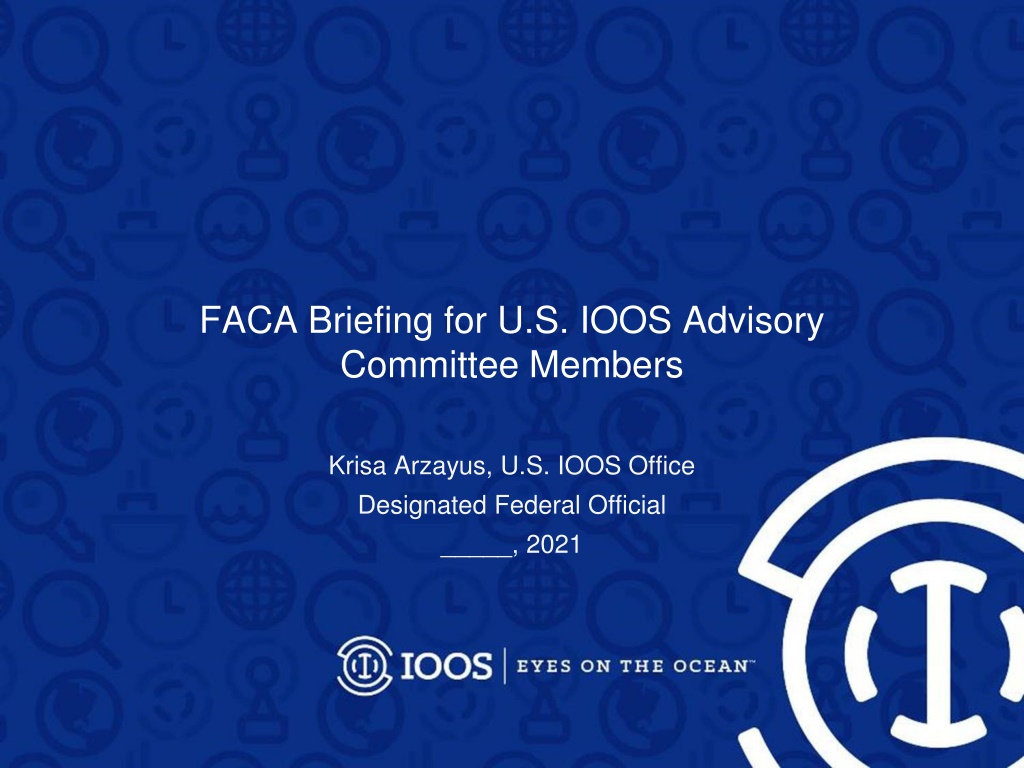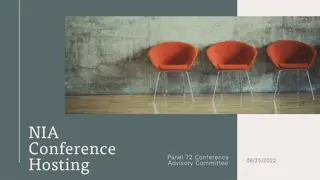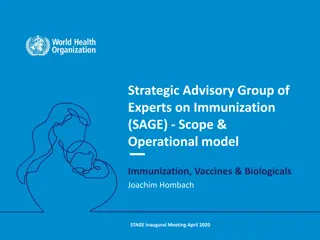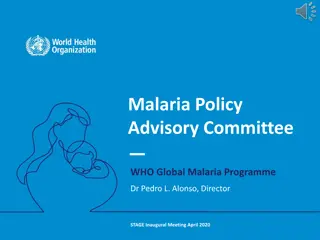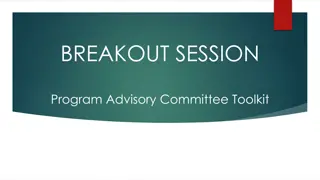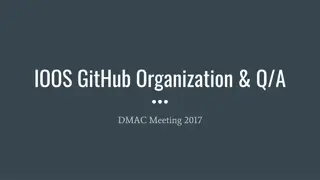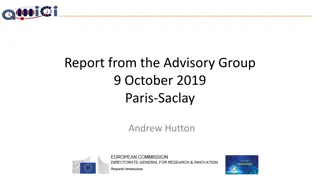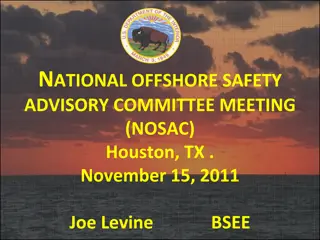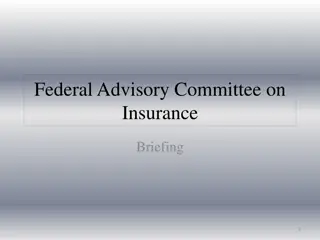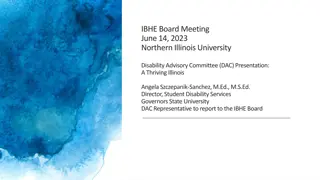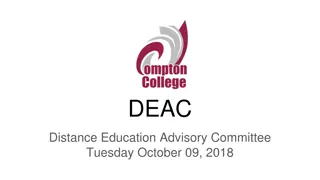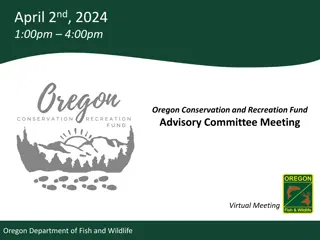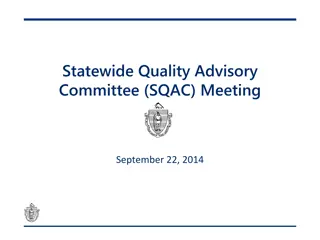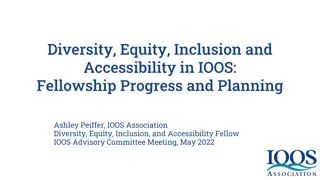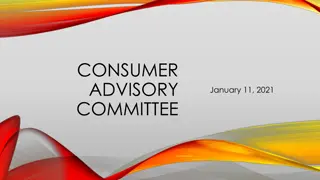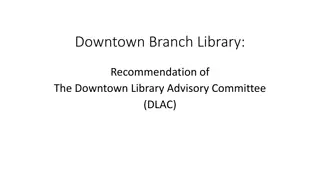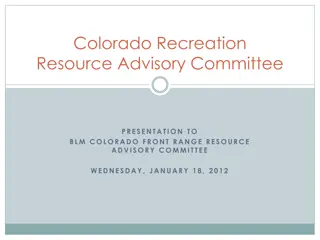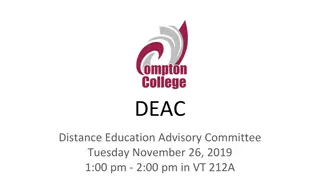U.S. IOOS Advisory Committee Overview
The U.S. IOOS Advisory Committee operates under the Federal Advisory Committee Act (FACA) to enhance public accountability and reduce wasteful expenditures. Established in 2012, it advises on matters related to the Integrated Coastal Ocean Observing System (ICOOS) Act and the Coordinated Ocean Observation and Research Act. The committee's responsibilities include advising the NOAA Administrator and the Interagency Ocean Observation Committee on U.S. IOOS administration, technology upgrades, user community needs, and information dissemination.
Download Presentation

Please find below an Image/Link to download the presentation.
The content on the website is provided AS IS for your information and personal use only. It may not be sold, licensed, or shared on other websites without obtaining consent from the author.If you encounter any issues during the download, it is possible that the publisher has removed the file from their server.
You are allowed to download the files provided on this website for personal or commercial use, subject to the condition that they are used lawfully. All files are the property of their respective owners.
The content on the website is provided AS IS for your information and personal use only. It may not be sold, licensed, or shared on other websites without obtaining consent from the author.
E N D
Presentation Transcript
FACA Briefing for U.S. IOOS Advisory Committee Members Krisa Arzayus, U.S. IOOS Office Designated Federal Official _____, 2021
Federal Advisory Committees Federal Advisory Committee Act P.L. 92-463, Oct 6, 1972 Federal Advisory Committees fulfill two basic purposes: To Enhance Public Accountability of Advisory Committees To Reduce Wasteful Expenditures on Advisory Committees 2
Federal Advisory Committee in General Federal Advisory Committee Act P.L. 92-463, Oct 6, 1972 Purpose #1: To Enhance Public Accountability of Advisory Committees To control the undue influence of special interests by balancing committee membership, and to ensure maximization of public access to committee deliberations. 3
Federal Advisory Committee Act P.L. 92-463, Oct 6, 1972 Purpose #2 To Reduce Wasteful Expenditures on Advisory Committees To improve the overall management of committee activities b implementing the following management controls. Monitor committee costs Eliminate unproductive or redundant committees Requires committees to produce an annual report of activities and accomplishments to the Congress
U.S. IOOS Federal Advisory Committee Authorizing legislation Integrated Coastal Ocean Observing System (ICOOS) Act (P.L. No 111-11, March 2009) Coordinated Ocean Observation and Research Act (COORA) (P.L. No 116-271 Title 1, December 2020) The U.S. IOOS Advisory Committee was established in 2012. U.S. IOOS AC is a statutory committee. U.S. IOOS AC is governed by FACA regulations. 12
U.S. IOOS AC Purpose The U.S. IOOS AC is charged with advising the NOAA Administrator and the Interagency Ocean Observation Committee (IOOC) on matters related to the purposes and responsibilities set forth in the Act and on appropriate matters the Administrator and IOOC refer to the Advisory Committee for review and advice. ? Those responsibilities and authorities in the original ICOOS Act of 2009: ? administration, operation, management, and maintenance of the U.S. IOOS, including integration of federal and non-federal assets and data management and communication ? expansion and periodic modernization and upgrade of technology components of the U.S. IOOS; ? identification of end-user communities, their needs for information provided by the U.S. IOOS, and the U.S. IOOS s effectiveness in disseminating information to end-user communities and the general public ? any other purpose identified by the Administrator or the Council. 6
U.S. IOOS AC Purpose ? Additional responsibilities and authorities: COORA 2020 (1 of 2) ? a national surface current mapping network designed to improve fine scale sea surface mapping using high frequency radar technology and other emerging technologies to address national priorities, including Coast Guard search and rescue operation planning and harmful algal bloom forecasting and detection that-- is comprised of existing high frequency radar and other sea surface current mapping infrastructure operated by national programs and regional coastal observing systems; incorporates new high frequency radar assets or other fine scale sea surface mapping technology assets, and other assets needed to fill gaps in coverage on United States coastlines; and follows a deployment plan that prioritizes closing gaps in high frequency radar infrastructure in the United States, starting with areas demonstrating significant sea surface current data needs, especially in areas where additional data will improve Coast Guard search and rescue models; 7
U.S. IOOS AC Purpose ? Additional responsibilities and authorities: COORA 2020 (2 of 2) ? fleet acquisition for unmanned maritime systems for deployment and data integration to fulfill the purposes of this subtitle; ? an integrative survey program for application of unmanned maritime systems to the real-time or near real-time collection and transmission of sea floor, water column, and sea surface data on biology, chemistry, geology, physics, and hydrography; ? remote sensing and data assimilation to develop new analytical methodologies to assimilate data from the System into hydrodynamic models; ? integrate multi-State monitoring to assess sources, movement, and fate of sediments in coastal regions; ? a multi-region marine sound monitoring system to be planned in consultation with the Interagency Ocean Observation Committee, the National Oceanic and Atmospheric Administration, the Department of the Navy, and academic research institutions; and developed, installed, and operated in coordination with the National Oceanic and Atmospheric Administration, the Department of the Navy, and academic research institutions 8
U.S. IOOS AC Meetings U.S. IOOS AC meetings are public meetings and are required by statute to be held at least once a year. Historically, the U.S. IOOS AC has had two public in person meetings per year and two virtual administrative meetings. FACA regulations state that advisory committees must document discussions and deliberations and make detailed meeting minutes available for public access. U.S. IOOS AC meeting minutes (and other information) are posted on the U.S. IOOS AC website shortly after each meeting event. Members of the public have access to all portions of U.S. IOOS AC meeting discussions and deliberations. 9
Voting Membership U.S. IOOS AC membership consists of 15 voting members, who are special government employees (SGE). An SGE s service may not exceed 130 days during any period of 365 consecutive days. SGE members are subject to Federal conflict of interest laws, agency standard of conduct regulations, and annual financial disclosure requirements. 10
Ex Officio Membership ? There are 5 non-voting Ex officio U.S. IOOS AC members. These members contribute to discussions, deliberations, meeting planning, and represent the views of their agencies, the IOOC, and the IOOS Association. Carrie Schmaus, U.S. Department of Energy Jennifer Hailes, Naval Meteorology and Oceanography Command John Haines, U.S. Geological Survey Laura Lorenzoni, National Aeronautics and Space Administration Josie Quintrell, IOOS Association 11
Past Recommendations In the past, Committees have opted to make recommendations to NOAA and the IOOC in the form of both formal correspondences (memos and letters) and detailed reports. All past recommendations and correspondences can be found on the IOOS AC Website. The most recent recommendation report, delivered June 2021, is available here.
FACs and Lobbyists Registered lobbyists are NOT eligible to serve on any federal advisory committee. On an annual basis, each U.S. IOOS AC member must certify that they are not a registered lobbyist. This info is submitted with yearly financial disclosure documentation. 13
Member Responsibilities U.S. IOOS AC members attend and actively participate in all meetings, whether in person or by teleconference. Come to meetings prepared: Read briefing materials in advance; and Prepare questions or points of interest in advance. Actively serve on subcommittees/working groups established by the NOAA Administrator. Provide specific, timely, and actionable advice and/or recommendations that are based on independent judgment. Keep the purpose of the U.S. IOOS AC in focus. Be aware of your role, and your independent judgment based on your expertise. Members of the U.S. IOOS AC DO NOT represent their organizations or employers. 14
Restrictions on Members Activities U.S. IOOS AC members may NOT use their access to the Federal government as a member of an advisory committee to solicit business or otherwise seek economic advantage for themselves or their companies. Members may NOT represent themselves as members of a NOAA advisory committee on business or personal cards or letterhead. Members may NOT use any non-public information obtained in the course of their duties as an U.S. IOOS AC member for personal gain or for that of the company or employer. 15
Restrictions on Members Activities (cont.) U.S. IOOS AC members must hold any non-public information in confidence. The U.S. IOOS AC as a whole may advise the agency on legislation or recommend legislative action. However In their official capacities as members of a committee, individual members may NOT petition or lobby Congress for or against particular legislation or encourage others to do so. Members of committees are advisors to NOAA and have NO authority to speak for the committee, the agency, or for the U.S. Department of Commerce outside of the committee structure. 16
Restrictions on Members Activities (cont.) U.S. IOOS AC members may NOT testify before Congress in their capacity as a member of the U.S. IOOS AC. If requested to testify before Congress, U.S. IOOS AC members: Cannot represent or speak for the committee, NOAA, the U.S. Department of Commerce, or the Administration in their testimony. Cannot provide information or comment on committee recommendations that are not yet publicly available. May state that they are a member of the committee. May speak to the personal observations as to their service on the committee. 17
Contact Information Krisa Arzayus, Ph.D. Deputy Director, U.S. IOOS Office U.S. IOOS AC Designated Federal Official NOAA, U.S. IOOS Office SSMC3, Room 2616 1315 East West Highway Silver Spring, MD 20910 Tel: (240)533-9455 Email: krisa.arzayus@noaa.gov 18
